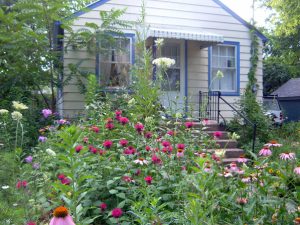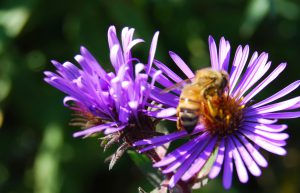Pollinator gardens are a great way to add interest and diversity to your home and the city landscape. These gardens are designed to attract bees, butterflies, moths, flies, beetles, bats, and even hummingbirds. But why would you want these critters in your backyard? These animals perform the crucial ecosystem service of pollination–making it possible for our food and flowers to grow! However, many bees and butterflies are habitat-specific, and the loss of habitat that provides sites for overwintering, foraging for pollen and nectar, or nesting can be detrimental to these species. Creating a pollinator garden for your home can be a relatively simple task, requiring low maintenance and upkeep, and can have a positive impact on these important critters.
Bees and other insect pollinators are beset by the same environmental challenges as most species, including habitat loss, degradation, and fragmentation; non-native species and diseases; pollution, including pesticides; and climate change. Much pollinator habitat has been lost to agriculture, resource extraction, and urban and suburban development.
Restoring habitat for pollinators includes choosing to grow the native plants on which local populations of bees and butterflies depend. For example, the Environmental cooperative has collected seeds from the Vassar Farm and Ecological Preserve and will be using them in pollinator gardens on Vassar’s campus and in the City of Poughkeepsie. Native plants are preferred for a pollinator garden over non-natives because they are often already adapted to the local environment, and have a better chance of being successful for that area. This is why it is so important to be selective in choosing the type of plants for your garden! ‘Naturalized’ areas (like your garden) provide valuable benefits, especially when planted in urban settings. Urban spaces, like your own backyard, can increase the connectivity of habitat for pollinators. This means that they have somewhere to stop and refuel as they travel through urban spaces on their way to larger sites of refuge.

This is what a pollinator garden could look like. How beautiful!
Now you know what a pollinator garden is, and why they are important in urban spaces. What next? After planting your pollinator garden, consider joining fun ‘citizen science’ efforts such as bumblebee watch. Reporting sightings of bumblebees in your garden is a great activity for families. Take a photo of the bees and other pollinators visiting your plants, then log them into a national database! These databases are vital for tracking instances of disease across certain areas and monitoring the success of efforts like pollinator gardens for a regional locality–like Dutchess County.
In Poughkeepsie, restoring habitat for pollinators would require growing native plants on which local populations of bees and butterflies depend. Seeds from pollinator-friendly plants can be saved from a number of places. A general guideline is to make sure your seed harvest does not exceed more than ⅓ of the plant’s total viable seed. At the Environmental Cooperative, we use seed collected from the Vassar Farm and Ecological Preserve that can be used throughout Poughkeepsie to benefit pollinators. Be sure to get permission from landowners before collecting seed on private property!

A bee visits a New England Aster plant in College Hill Park
